Mechanistic Study of Groove Parameters on the Thermoelastic Instability of Wet Clutch
Abstract
1. Introduction
2. Numerical Model
2.1. Multi-Physics Field Coupling Analysis
2.2. Heat Conduction Equation
2.3. Heat Flow Density
2.4. Convection Heat Transfer Coefficient
3. Distribution of Initial Temperature
3.1. Establishment of Finite Element Model
3.2. Temperature Characterization
4. Effect of Groove Parameters on the Thermoelastic Instability
4.1. Number of Grooves
4.2. Depth of Groove
4.3. Tilt Angle of Grooves
5. Conclusions
- (1)
- Increasing the number of friction plate grooves enhances the frequency of cooling oil circulation in the circumferential direction, which improves the cooling effect on the friction surface. As a result, the distribution of high-temperature hotspots on the steel disc surface becomes more concentrated, with the temperature distribution shifting from distinct hotspots to a more uniform high-temperature zone. Consequently, both the maximum temperature and the radial temperature gradient on the steel disc surface decrease.
- (2)
- Increasing the depth of the friction plate grooves causes the distribution of high-temperature hotspots on the steel disc surface to become more dispersed. Initially, the maximum temperature decreases, but after reaching a certain point, it begins to increase again.
- (3)
- Increasing the tilt angle of the friction plate grooves results in a smaller change in the maximum temperature on the steel disc surface. The distribution of high-temperature areas shifts from hotspot clustering to a more uniform high-temperature zone. Additionally, the direction of the groove tilt influences the magnitude of the maximum temperature on the steel surface.
Author Contributions
Funding
Data Availability Statement
Conflicts of Interest
References
- Jin, J.; Li, X.; Yang, S.; Yi, H.; Sun, H.; Hao, W. Calculation and analysis of wet clutch sliding torque based on fluid-solid coupling dynamic behavior. Tribol. Int. 2025, 202, 110363. [Google Scholar] [CrossRef]
- Wirkner, J.; Baese, M.; Lebel, A.; Pflaum, H.; Voelkel, K.; Pointner-Gabriel, L.; Besser, C.; Schneider, T.; Stahl, K. Influence of Water Contamination, Iron Particles, and Energy Input on the NVH Behavior of Wet Clutches. Lubricants 2023, 11, 459. [Google Scholar] [CrossRef]
- Sergienko, N.; Kalinin, P.; Pavlenko, I.; Ochowiak, M.; Ivanov, V.; Sergienko, A.; Pavlova, N.; Basova, Y.; Titarenko, O.; Nazarov, A.; et al. Synthesis of the energy-saving dry dual clutch control mechanism. Appl. Sci. 2023, 13, 829. [Google Scholar] [CrossRef]
- Doos, Q.M.; Hussain, I.Y.; Abd Al-Sahb, W.; Abdullah, O.I.; Al-Tamimi, A.N.J. Frictional material selection of dry clutch disc based on the weighted factor and finite element methods. Heat Transf. 2023, 52, 2838–2858. [Google Scholar] [CrossRef]
- Ma, B.; Chen, X.; Zheng, C.; Yu, L.; Zhao, Q.; Lu, W. Study on Spline Stress of Separator Plates in a Wet Multi-Plate Clutch. Materials 2024, 17, 3039. [Google Scholar] [CrossRef]
- Kim, S.; Lee, H.; Kim, J.; Park, G. Online adaptive identification of clutch torque transmissibility for the drivability consistency of high-performance production vehicles. Control Eng. Pract. 2024, 147, 105926. [Google Scholar] [CrossRef]
- Xiao, Y.; Li, Q.; Liu, H. The Optimization and Control of the Engagement Pressure for a Helicopter Dry Clutch. Machines 2024, 12, 533. [Google Scholar] [CrossRef]
- Schneider, T.; Voelkel, K.; Pflaum, H.; Stahl, K. Investigating Failure Modes and Performance Impacts of Wet Clutches in Automotive Limited Slip Differentials. Lubricants 2024, 12, 70. [Google Scholar] [CrossRef]
- Schneider, T.; Bedrikow, A.B.; Dietsch, M.; Voelkel, K.; Pflaum, H.; Stahl, K. Machine learning based surrogate models for the thermal behavior of multi-plate clutches. Appl. Syst. Innov. 2022, 5, 97. [Google Scholar] [CrossRef]
- Schneider, T.; Zilkens, A.; Voelkel, K.; Pflaum, H.; Stahl, K. Failure modes of spontaneous damage of wet-running multi-plate clutches with carbon friction linings. Tribol. Trans. 2022, 65, 813–826. [Google Scholar] [CrossRef]
- Wu, J.; Li, P.; Wang, L.; Huang, X.; Yang, J.; Du, M. The RUL prediction based on improved Wiener degradation model for wet friction components. Meas. Sci. Technol. 2024, 35, 076126. [Google Scholar]
- Zhang, J.; Liu, X.; Wei, H.; Liu, M.; Huang, W.; Yan, X. Study on Shifting Performance of Tractor Multi-Clutch under Different Engagement Rules. Agriculture 2024, 14, 254. [Google Scholar] [CrossRef]
- Shi, G.; Zhang, H.; Yang, X.; Xu, X.; Sun, X. Research on the Optimal Control of Working Oil Pressure of DCT Clutch Based on Linear Quadratics Form. Machines 2024, 12, 903. [Google Scholar] [CrossRef]
- Park, J.-Y.; Jeon, J.-H.; Kim, Y.-C. A Study on Power Transmission Control for Applying MR Fluid Multi-Plate Clutch to Automobile Power Distribution Device. Appl. Sci. 2024, 14, 3871. [Google Scholar] [CrossRef]
- Liu, Y.; Yuanzhi, Y.; Gao, Z.; Jin, S.; Zhou, R.; Tao, G. Investigation of thermal behavior of a novel multi-conical friction pair during wet clutch’s engagement based on finite difference method. Int. Commun. Heat Mass. Transf. 2024, 155, 107555. [Google Scholar]
- Wang, Q.; Zhang, X.; Wang, D.; Cui, H.; Zhang, S.; Wang, J. Numerical simulation and experimental investigation on the thermal-fluid-solid multi-physical field coupling characteristics of wet friction pairs considering cavitation effect. Appl. Therm. Eng. 2025, 260, 124955. [Google Scholar]
- Liu, Y.; Sun, Y.; Gao, Z.; Ye, F.; Tang, P. Transient temperature characteristics of friction clutch disc considering thermal contact conductance under sliding conditions. Friction 2023, 11, 2253–2263. [Google Scholar]
- Gao, J.; Yin, C.; Jiang, C. Research on clutch position control based on backstepping method for small-sized tractors. Sci. Prog. 2023, 106, 00368504231172602. [Google Scholar]
- Wu, J.; Yan, H.; Liu, S.; Ni, D. Study on nonlinear dynamics characteristics of dual speed dual clutch transmission system based on bond graph. Heliyon 2023, 9, e20862. [Google Scholar] [CrossRef]
- Berkefeld, J.; Bartel, D. The influence of the metallic friction counterpart on the occurrence of negative friction coefficient gradients in controlled, dry-running clutch systems. Tribol. Int. 2023, 186, 108644. [Google Scholar]
- Wei, D.; Xiong, Q.; Dong, J.; Wang, H.; Liang, X.; Tang, S.; Xu, X.; Wang, H.; Wang, H. Electrostatic Adhesion Clutch with Superhigh Force Density Achieved by MXene–Poly(Vinylidene Fluoride–Trifluoroethylene–Chlorotrifluoroethylene) Composites. Soft Robot. 2023, 10, 482–492. [Google Scholar]
- Bălășoiu, G.; Munteniță, C.; Amortila, V.T.; Titire, L. Optimisation of Clutch Disc Friction Material Using a Multi-Layer Perceptron Artificial Neural Network. Polymers 2024, 16, 3588. [Google Scholar] [CrossRef]
- Ahn, D.-V.; Kim, K.; Choi, K.; Lee, J.W.; Kim, J.-G.; Yu, J.; Kim, H.-S.; Seo, J.; Park, Y.-J. Effect of clutch control to improve launch quality for a power shuttle tractor during launching. Comput. Electron. Agric. 2024, 224, 109235. [Google Scholar]
- Kurian, J.; Sridharan, N.V.; Chakrapani, G.; Vaithiyanathan, S. Health monitoring of automotive clutch system through feature fusion and application of tree-based classifiers. Struct. Health Monit. 2024. [Google Scholar] [CrossRef]
- Diao, Z.; Zhang, Y.; Li, C.; Liu, X.; Liu, Z. Dynamic Characteristics of an Automotive Air-Conditioning Electromagnetic Clutch. Processes 2023, 12, 80. [Google Scholar] [CrossRef]
- Wu, J.; Zhao, P.; Cui, J.; Wang, L.; Yang, C.; Ouyang, J. Data-Driven Prediction of Coefficient of Friction in Wet Friction Components: A Model Development and Interpretability Analysis. J. Tribol. 2025, 147, 074601-1. [Google Scholar]
- Chakrapani, G.; Sugumaran, V. Transfer learning based fault diagnosis of automobile dry clutch system. Eng. Appl. Artif. Intell. 2023, 117, 105522. [Google Scholar]
- Li, J.; Gu, J.; Zhang, Y.; Wang, Z.; Zhang, G. Study on laser cladding process and friction characteristics of friction pairs of copper-based powder metallurgy materials. Tribol. Int. 2023, 177, 107953. [Google Scholar]
- Zhang, C.; Yu, W.; Fan, C.; Kong, C.; Xu, J.; Shao, Y. Theoretical and experimental investigation on teeth impacts between the inner hub and the friction plate of the planetary transmission system’s clutch. J. Sound Vib. 2023, 553, 117674. [Google Scholar]
- Xue, Q.; Zhang, X.; Chen, H.; Yue, M.; Teng, T.; Yu, J. Dynamic coordinated control strategy of a dual-motor hybrid electric vehicle based on clutch friction torque observer. Heliyon 2024, 10, e27255. [Google Scholar]
- Zhou, Y.; Shi, X.; Guo, D.; Dazer, M.; Bertsche, B.; Mei, Z. Experimental investigation of gear rattle and nonlinear dynamic interaction in a dual-clutch transmission. Appl. Acoust. 2023, 204, 109233. [Google Scholar]
- Ahn, H.-J.; Park, Y.-J.; Kim, S.-C.; Choi, C. Theoretical Calculations and Experimental Studies of Power Loss in Dual-Clutch Transmission of Agricultural Tractors. Agriculture 2023, 13, 1225. [Google Scholar] [CrossRef]
- Wang, L.; Yan, Z.; Li, H.; Lei, H.; Xie, M. Study of the Judder Characteristics of Friction Material for an Automobile Clutch and Test Verification. Chin. J. Mech. Eng. 2023, 36, 53. [Google Scholar]


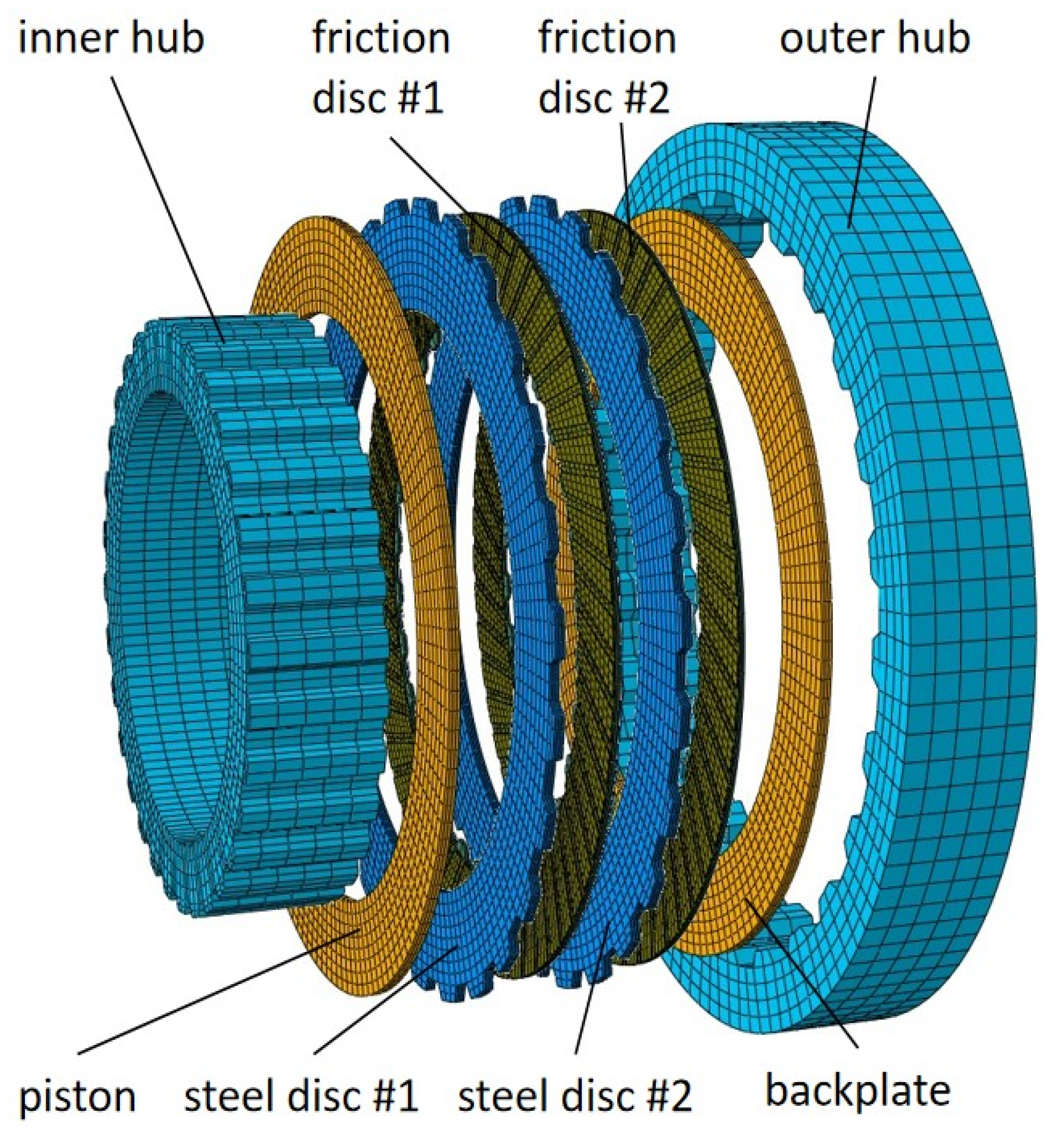
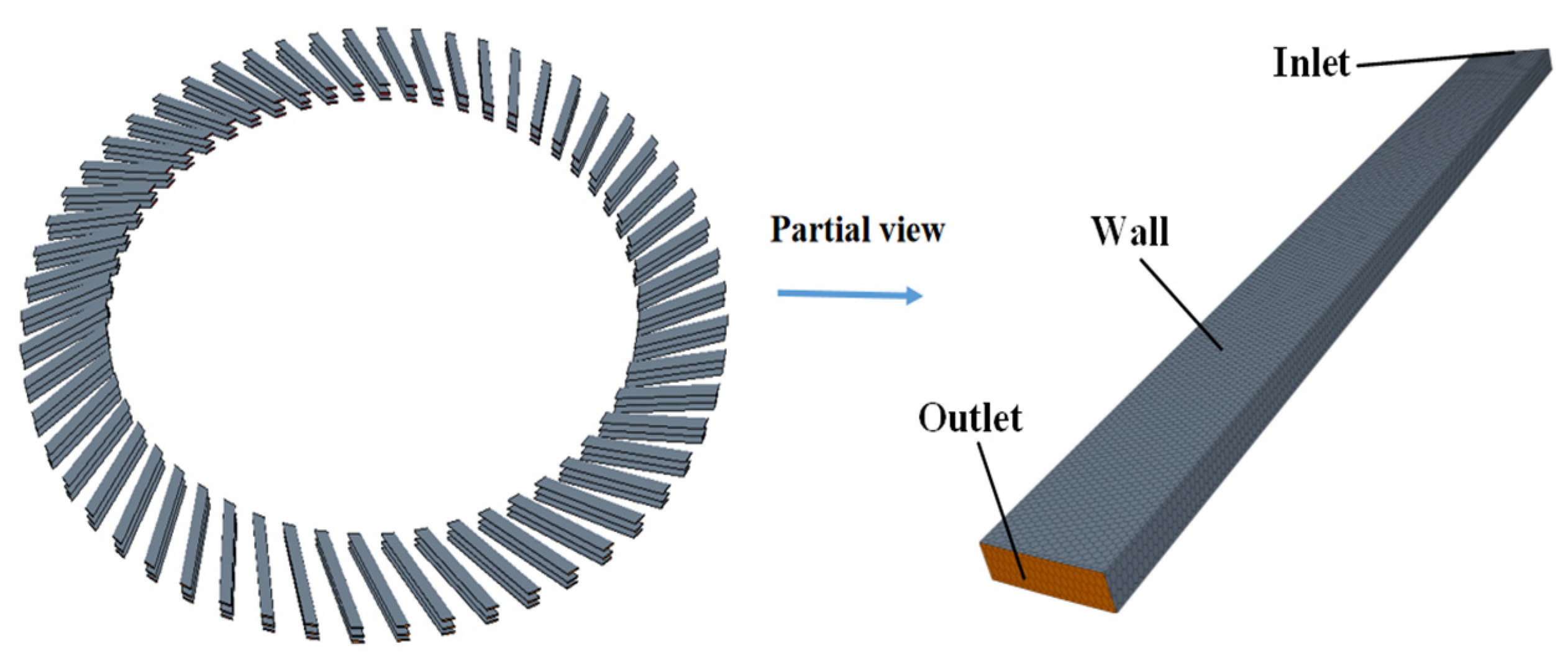
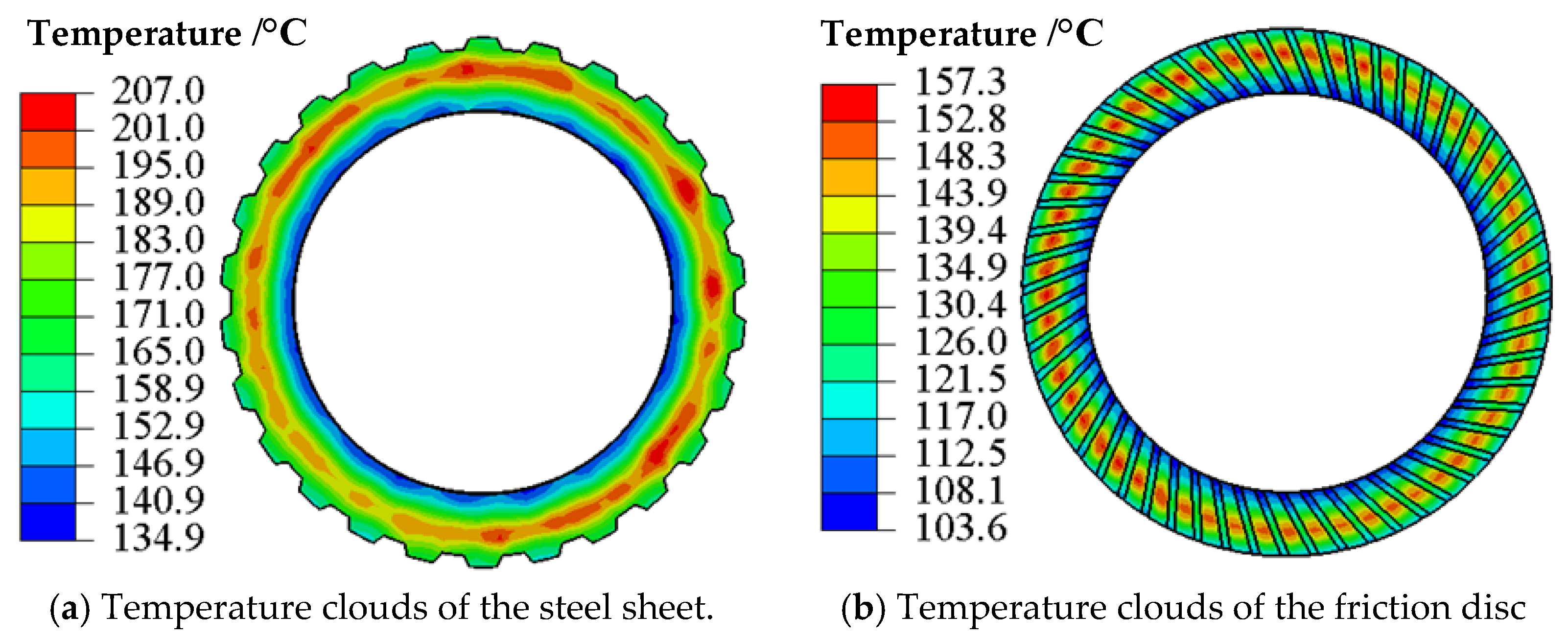

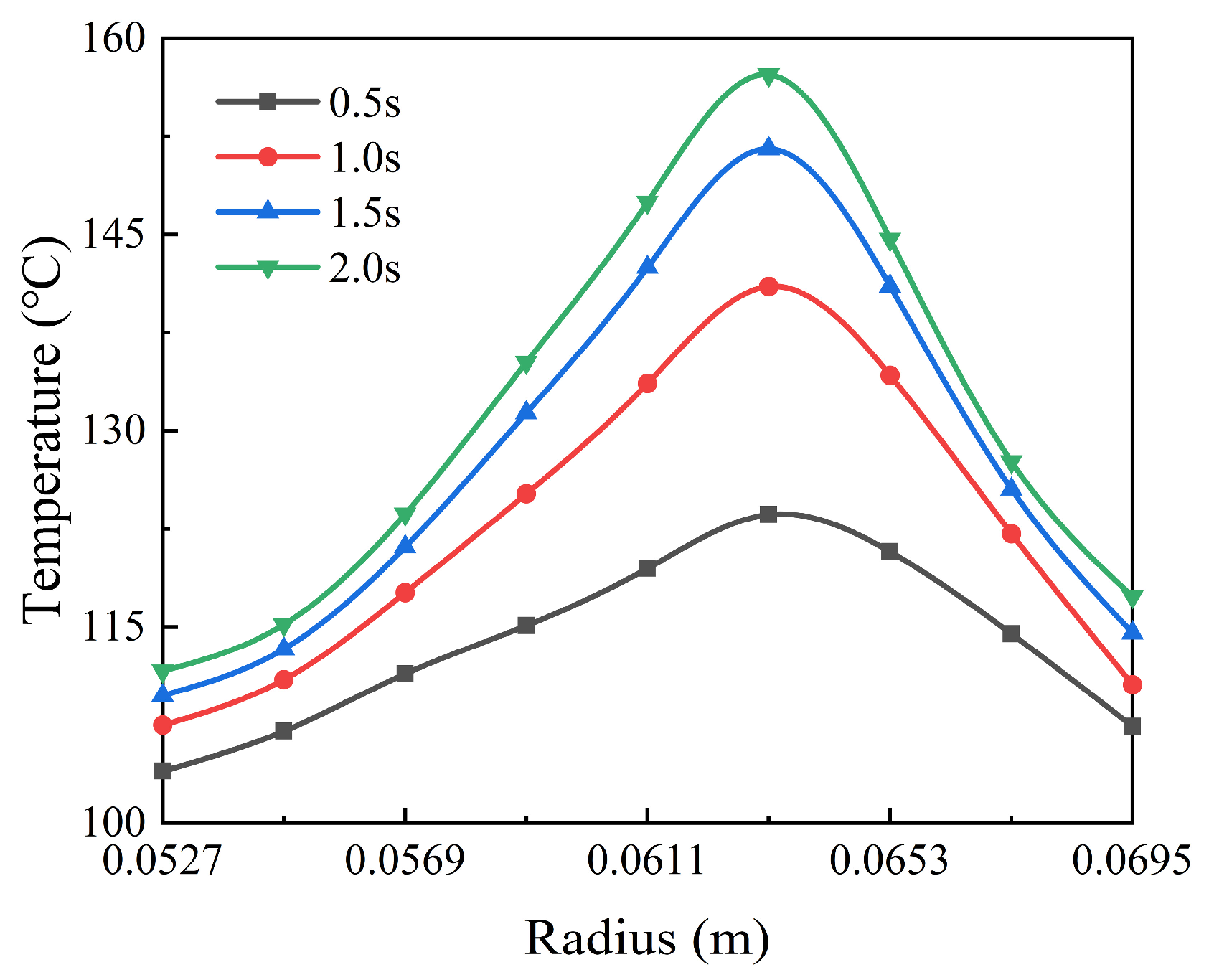
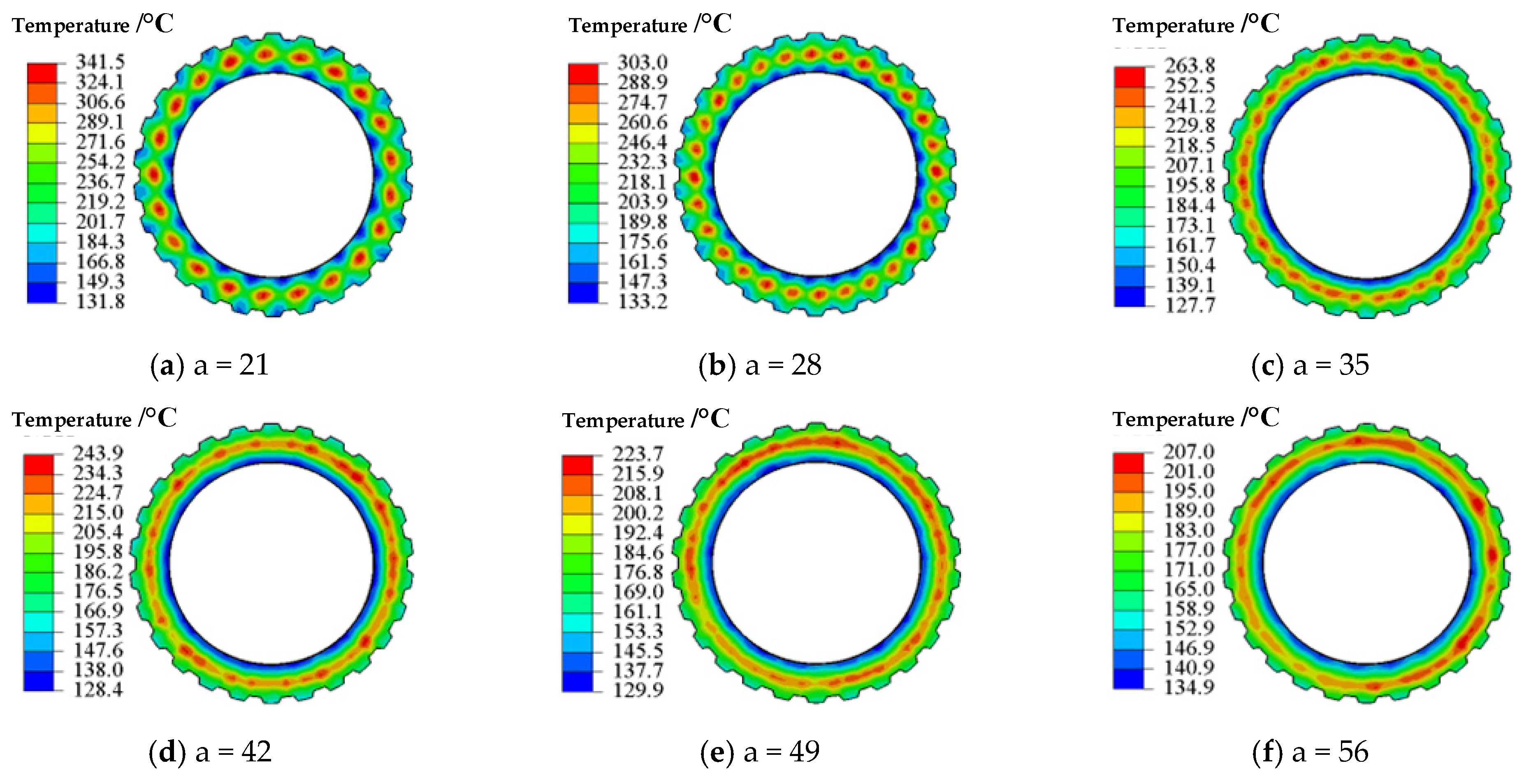
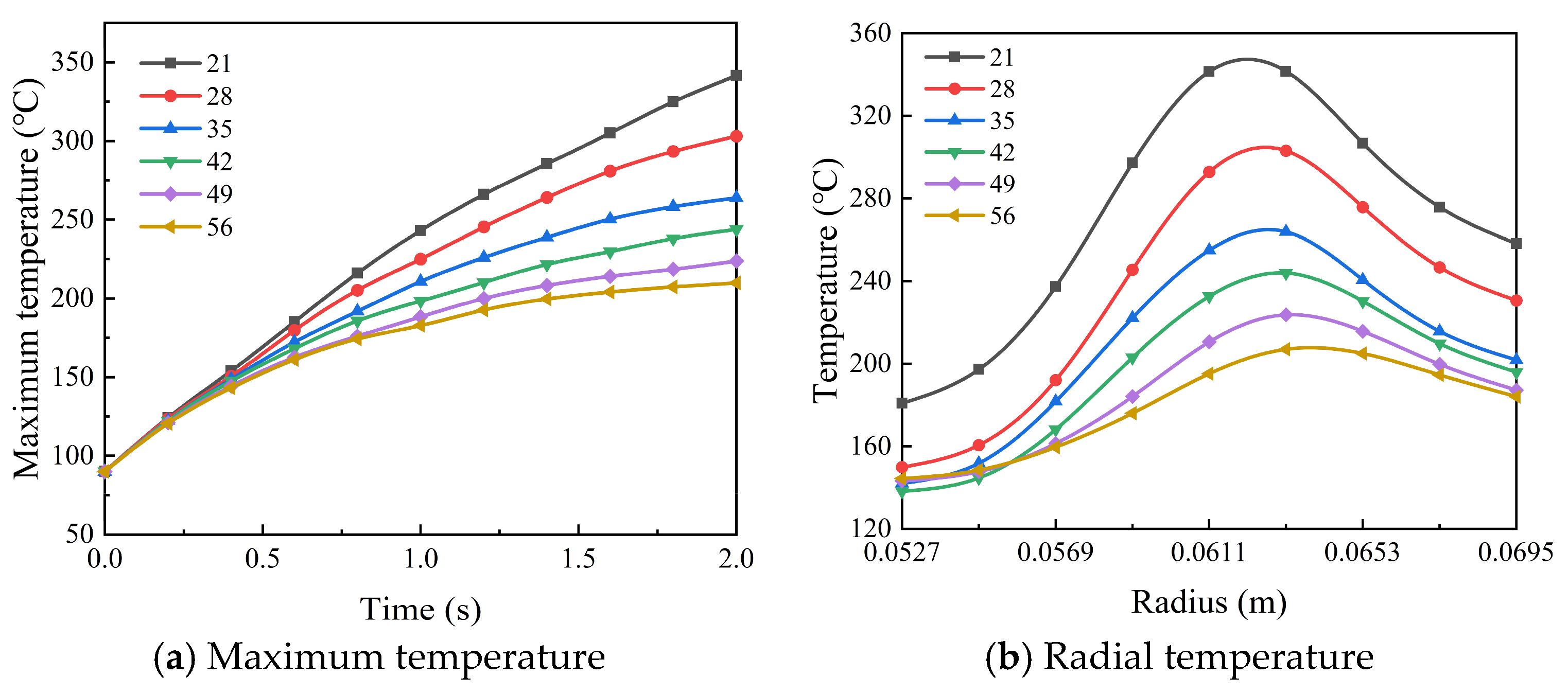
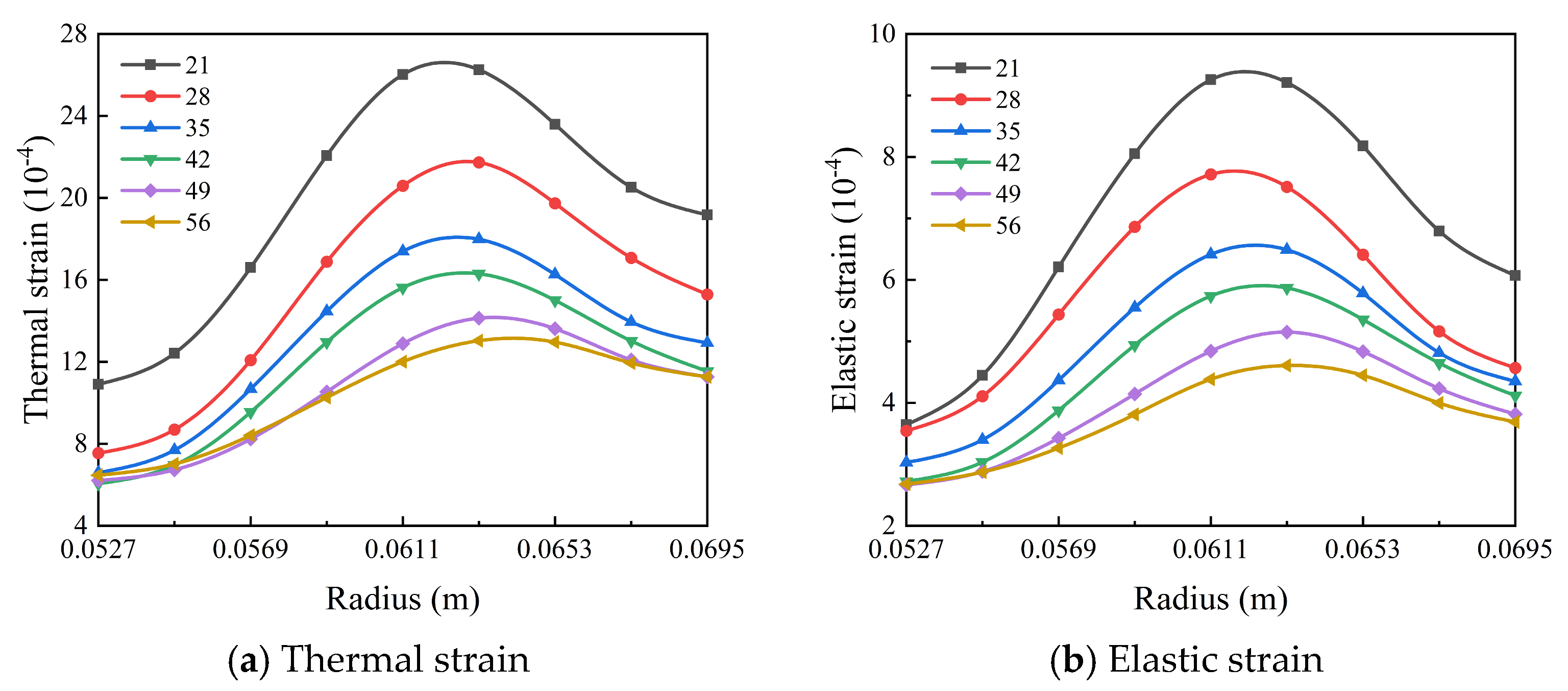

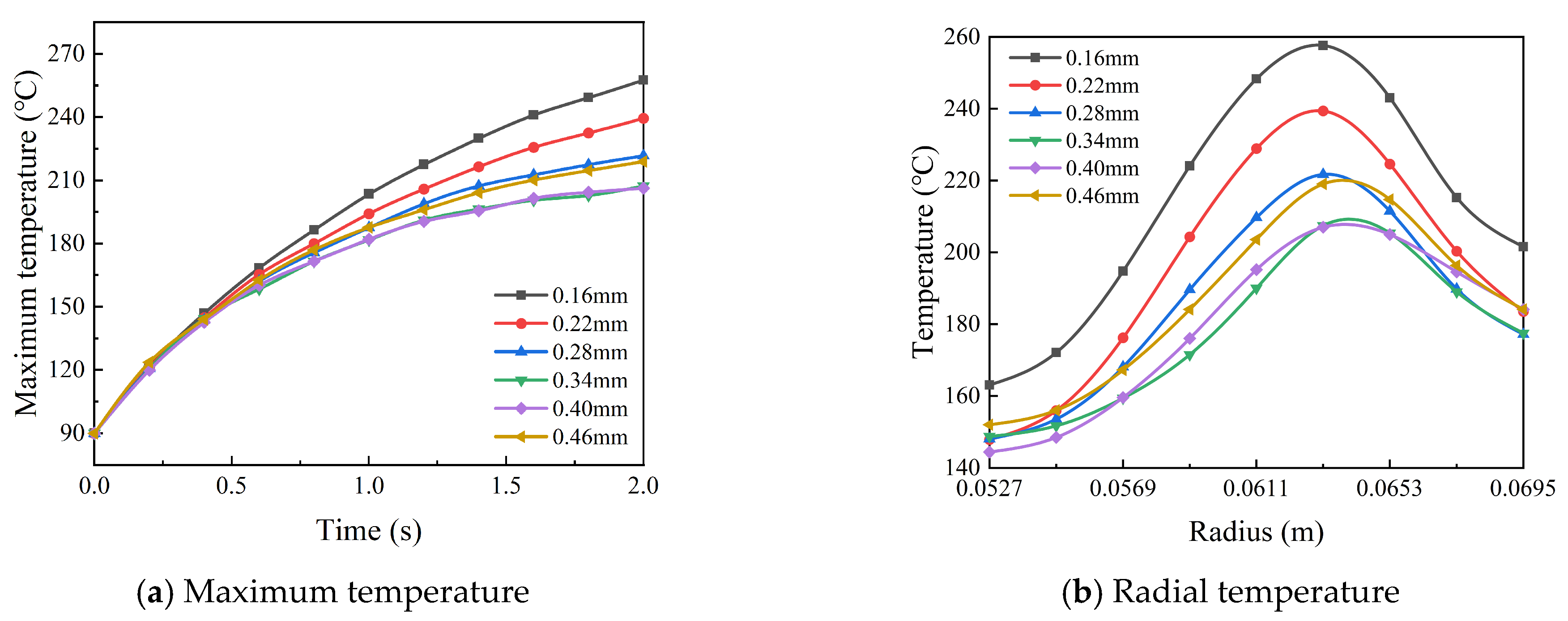
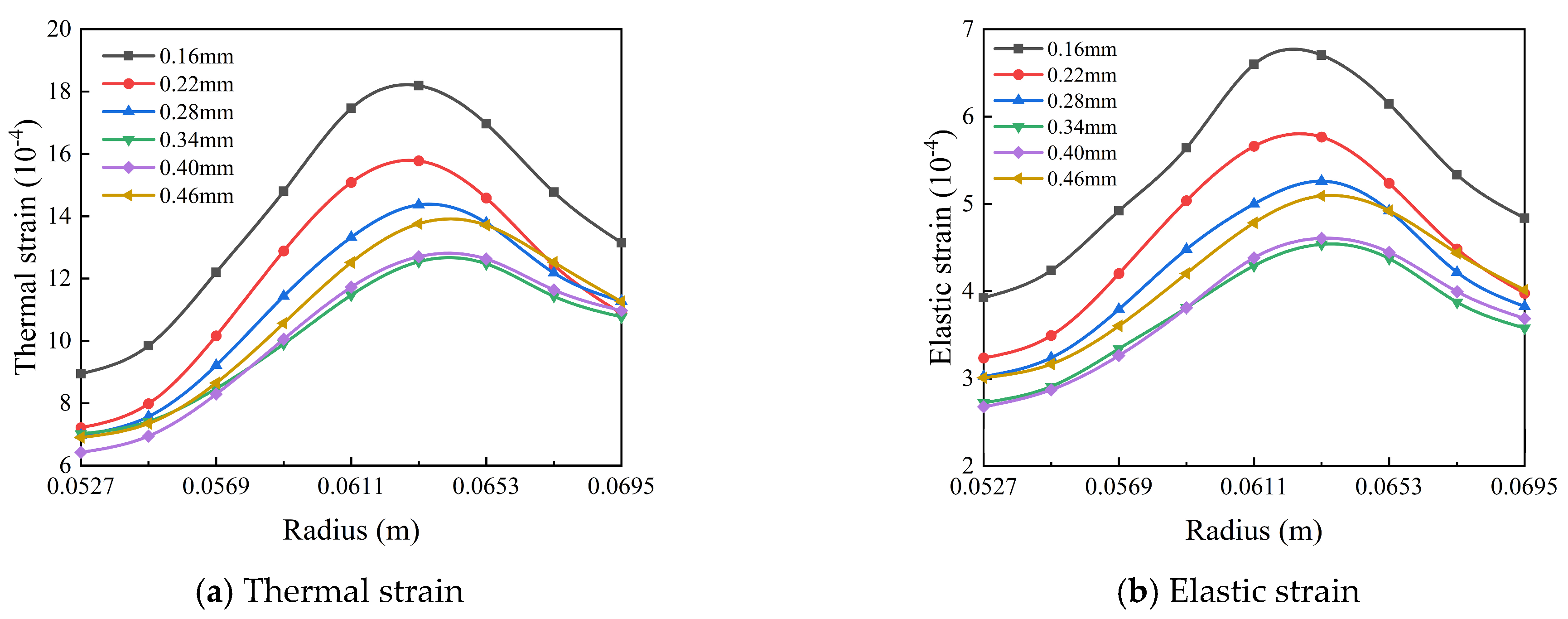

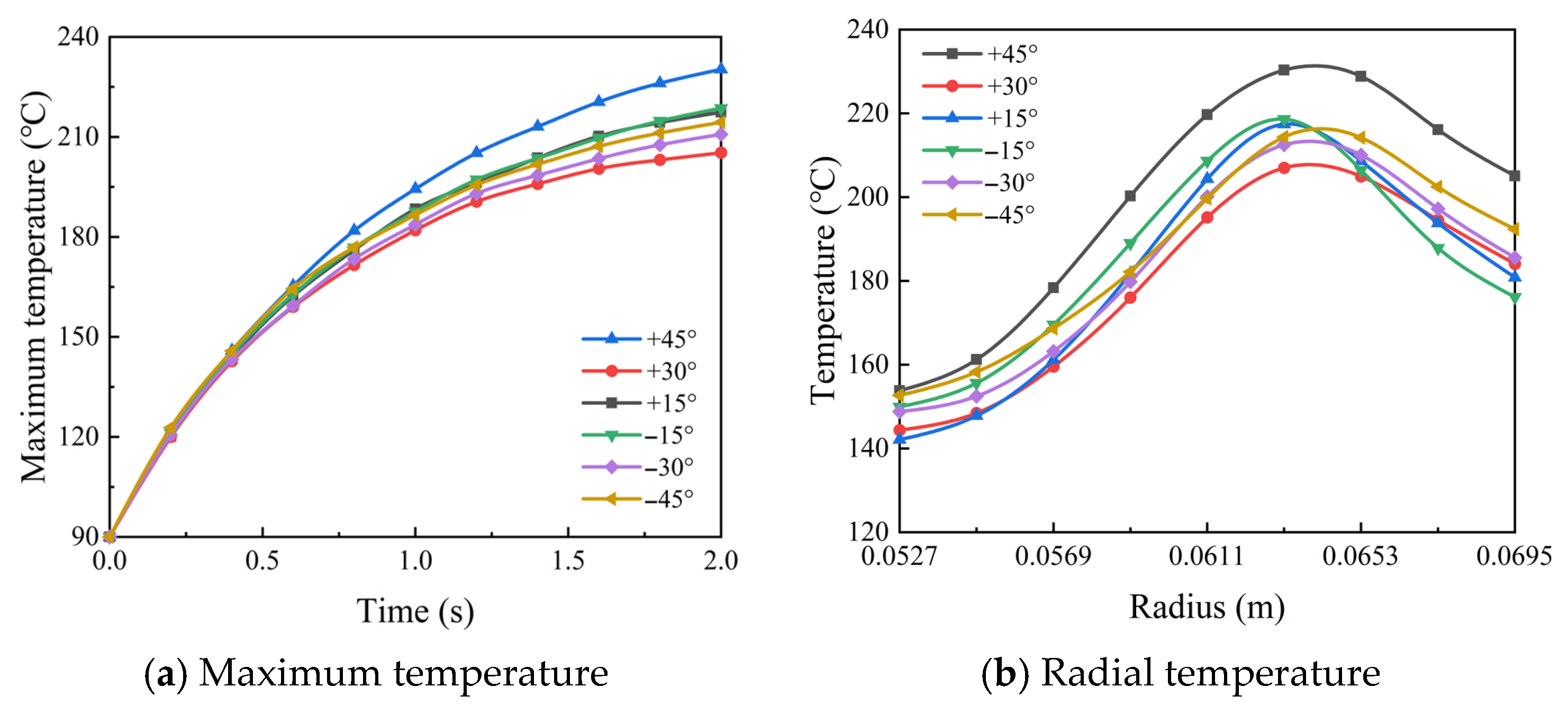
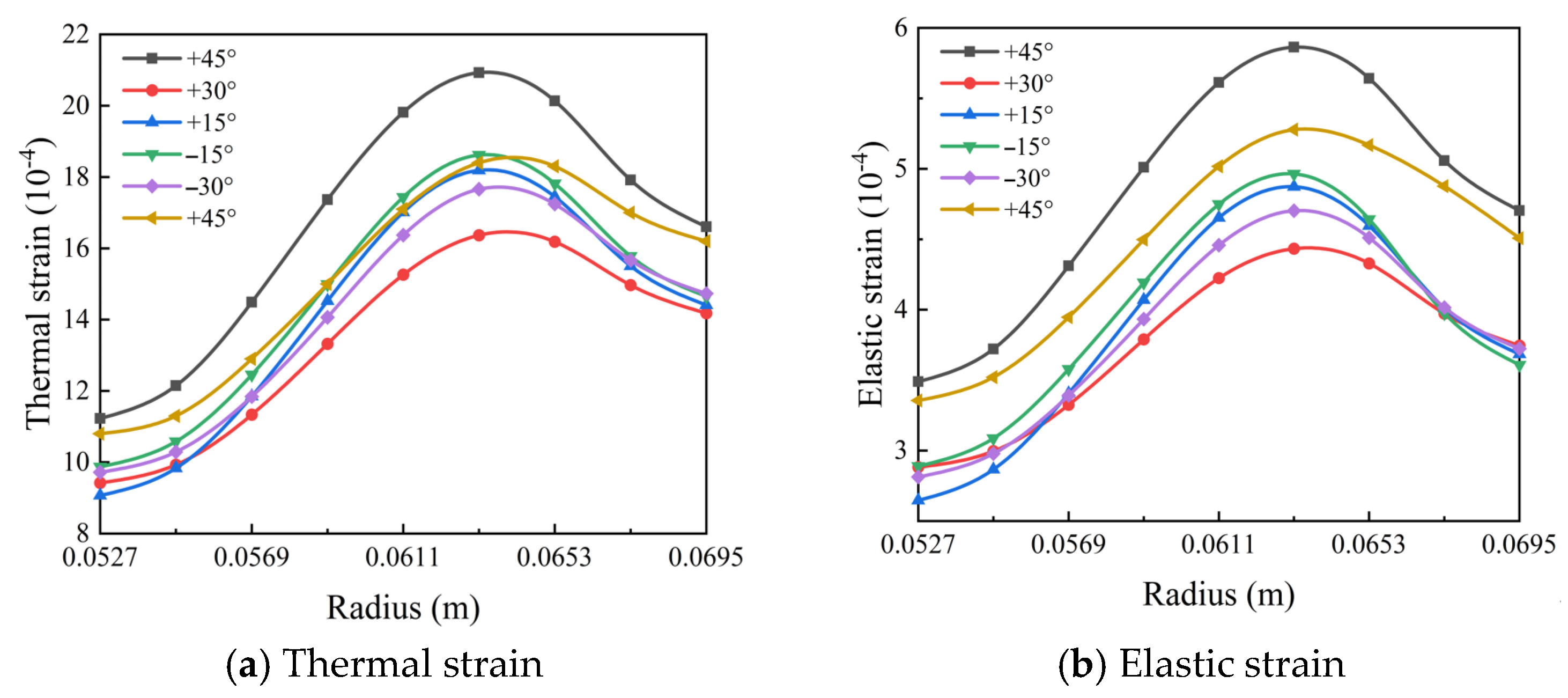
| Parameters | Steel Disc | Friction Core | Friction Linings |
|---|---|---|---|
| Inner radius, rin/m | 0.105 | 0.105 | 0.105 |
| Outer radius, rout/m | 0.139 | 0.139 | 0.139 |
| Thickness, H/m | 0.0018 | 0.008 | 0.0049 |
| Number of grooves, a | - | - | 56 |
| Depth of grooves, b/m | - | - | 0.004 |
| Tilt angle of grooves, α | - | - | 30° |
| Density ρ/(Kg·m−3) | 7800 | 7800 | 750 |
| Specific heat capacity, c/(J·Kg−1·K−1) | 452 | 452 | 1610 |
| Thermal expansion rate λ/(10−5) | 1.15 | 1.15 | 1 |
| Therma conductivity, γ/(W·m−1·K−1) | 54 | 54 | 5 |
| Elastic modulus, ν/(GPa) | 200 | 200 | 1 |
| Poisson’s ratio, μ | 0.3 | 0.3 | 0.05 |
| Parameters | Value |
|---|---|
| Density, ρ/(kg·m−3) | 852 |
| Thermal conductivity, k/(W∙m−1∙K−1) | 0.138 |
| Specific heat capacity, c/(J∙Kg−1∙K−1) | 2131 |
| Power Viscosity, η/(kg∙m−1∙s−1) | 0.02556 |
Disclaimer/Publisher’s Note: The statements, opinions and data contained in all publications are solely those of the individual author(s) and contributor(s) and not of MDPI and/or the editor(s). MDPI and/or the editor(s) disclaim responsibility for any injury to people or property resulting from any ideas, methods, instructions or products referred to in the content. |
© 2025 by the authors. Licensee MDPI, Basel, Switzerland. This article is an open access article distributed under the terms and conditions of the Creative Commons Attribution (CC BY) license (https://creativecommons.org/licenses/by/4.0/).
Share and Cite
Zhang, Z.; Mu, Z.; Yu, X. Mechanistic Study of Groove Parameters on the Thermoelastic Instability of Wet Clutch. Lubricants 2025, 13, 150. https://doi.org/10.3390/lubricants13040150
Zhang Z, Mu Z, Yu X. Mechanistic Study of Groove Parameters on the Thermoelastic Instability of Wet Clutch. Lubricants. 2025; 13(4):150. https://doi.org/10.3390/lubricants13040150
Chicago/Turabian StyleZhang, Zhigang, Zhihua Mu, and Xiaoxia Yu. 2025. "Mechanistic Study of Groove Parameters on the Thermoelastic Instability of Wet Clutch" Lubricants 13, no. 4: 150. https://doi.org/10.3390/lubricants13040150
APA StyleZhang, Z., Mu, Z., & Yu, X. (2025). Mechanistic Study of Groove Parameters on the Thermoelastic Instability of Wet Clutch. Lubricants, 13(4), 150. https://doi.org/10.3390/lubricants13040150





